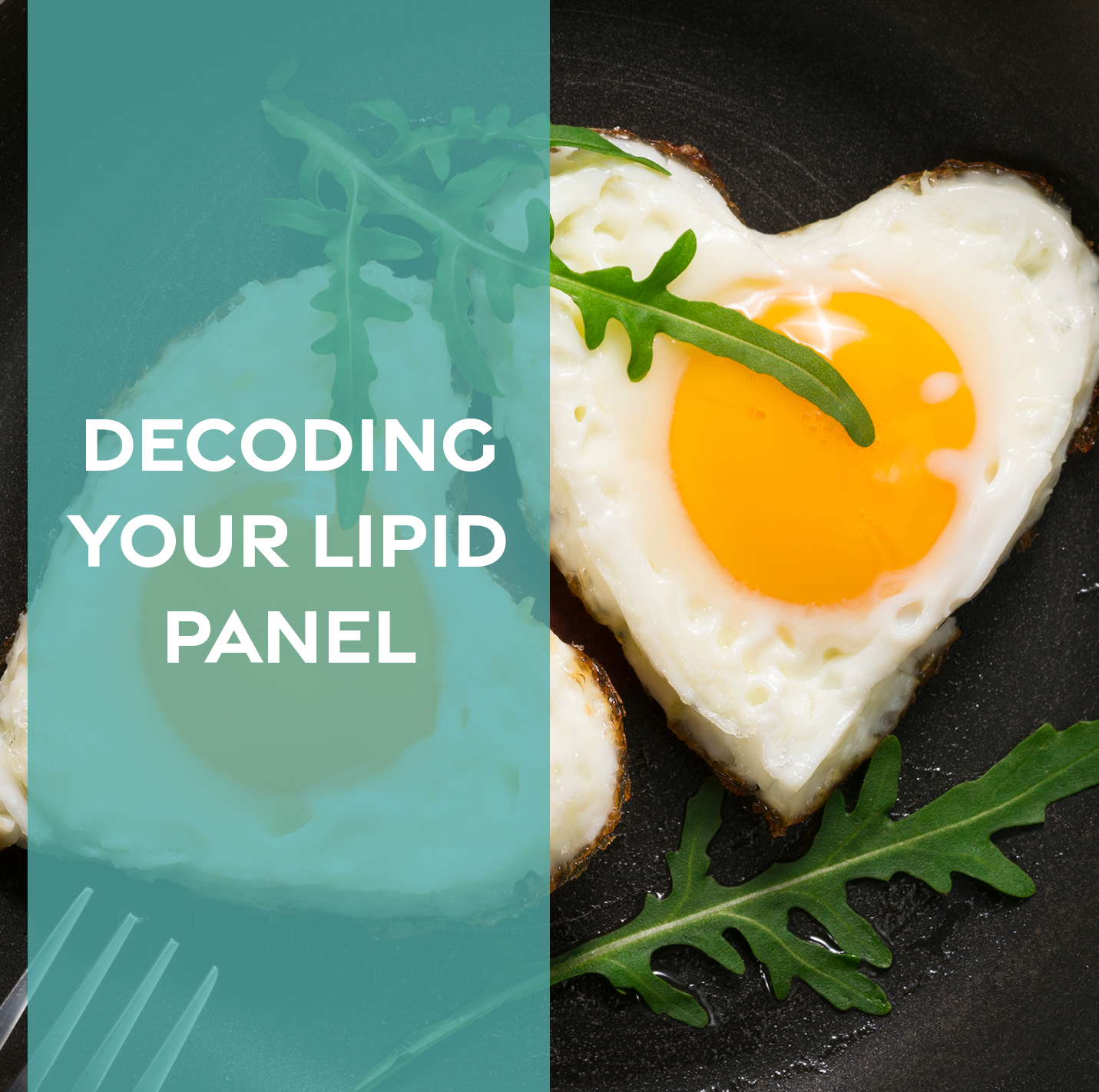When you go for your routine physical, your doctor will likely order a lipid panel, a blood test that measures the levels of cholesterol and other fats (lipids) in your blood. You might notice a few key terms that are important for understanding your heart health: total cholesterol, triglycerides, HDL, and LDL. While these terms are commonly used especially when discussing heart health, they can be confusing if you don’t fully understand what they mean or how they impact your heart.
In this blog post, we’ll break down each of these terms, explain the role they have in your body, and explore how the foods you eat can influence them. By understanding how these fats work, you can make more informed choices to improve your heart health!
What’s included in a lipid panel?
- Total cholesterol: This is the sum of all cholesterol in your blood. It includes your HDL, LDL and triglycerides. While a high total cholesterol level does not necessarily warrant concern on its own, it can indicate an increased risk of heart disease if other components of the lipid panel are abnormal.
- LDL (low-density lipoprotein) cholesterol: This is often referred to as the “bad” cholesterol. It carries cholesterol from the liver to the arteries. High levels of LDL can lead to a build-up of plaque in the arteries and increase the risk of heart attacks and strokes.
- HDL (high-density lipoprotein) cholesterol: This is known as the “good” cholesterol. It works to remove excess cholesterol from the bloodstream and bring it back to the liver for processing. Higher levels of HDL is associated with a lower risk of heart disease.
- Triglycerides: These are a type of fat that the body stores for energy. High triglyceride levels combined with low HDL and high LDL cholesterol levels, can increase your risk of developing heart disease.
Here’s another way to look at it—think of your LDL cholesterol as garbage on the street and your HDL cholesterol are the garbage cleaners. The more LDL there is, the more garbage is piling up and the streets get more narrow making it harder for cars to drive through. Now imagine those streets are your arteries. This ultimately leads to a build-up of plaque in your arteries, which makes it harder for blood to flow to your heart and increases the risk of heart attacks and strokes.
However, when we avoid consuming fat entirely to manage our cholesterol, we are not consuming any “garbage cleaners” to clean up the streets from what is currently there. This leaves the plaque in our arteries- and ultimately does not help change our current cholesterol status. That is why it is important to know what fats are considered HDL so we can include those to help lower your cholesterol. Thus, cleaning up the plaque that has built up in our arteries.
Nutrition and its influence on your lipid panel:
- Fats: Quality matters
- Saturated fats: These fats are found in animal products like fatty cuts of meat, processed meats, full-fat dairy products, and some plant-based oils such as coconut oil and palm oil. These types of fats can raise LDL which can contribute to plaque buildup in the arteries.
- Trans fats: These are artificial fats found in many processed, packaged, and fried foods. They are typically seen on food labels as “partially hydrogenated oil”. Trans fat not only raises LDL but lowers HDL cholesterol.
- Unsaturated fats: These are heart-healthy fats because they help lower LDL cholesterol while raising HDL cholesterol. They include both mono- and polyunsaturated fats, which are found in foods like olive oil, avocados, nuts, seeds, and fatty fish.
- Fiber → Fiber (particularly soluble fiber) binds to the LDL cholesterol in the digestive tract and removes it from the body which lowers LDL levels. Foods rich in soluble fiber include oats, barley, beans, lentils, apples, peans, and psyllium. Aim to get 25-35 grams of fiber in your diet daily.
- Omega 3-fatty acids → Omega-3 fatty acids are a type of polyunsaturated fat. They are found in fatty fish (salmon, mackerel, sardines, etc), chia seeds, flaxseeds, and walnuts. Omega-3 fatty acids have been shown to help improve lipid levels. Try to eat two servings of fatty fish per week or try adding chia seeds or ground flax seeds to smoothies or Greek yogurt.
- Plant sterols/stanols → Plant sterols and stanols are naturally occurring compounds that can help block the absorption of cholesterol in the intestines. They are found in small amounts in fruits, vegetables, nuts, and seeds, and are also added to some fortified foods.
- Refined carbohydrates/Sugar → High intake of refined carbohydrate foods can lead to elevated triglycerides and lower HDL levels. Opt for whole grains, limit sugar-sweetened beverages, and try choosing naturally sweeter fruits for snacks for a heart-healthy diet.
Lifestyle factors that influence your lipid panel:
- Exercise: Regular exercise can help raise HDL cholesterol levels and lower triglycerides. Aim for at least 150 minutes of moderate-intensity aerobic exercises per week or 75 minutes of vigorous-intensity aerobic exercises per week. This can include a variety of different exercises such as walking at a moderate pace, running, cycling, and swimming.
- Weight: Maintaining a healthy weight helps keep lipid levels in normal ranges. Focus on a balanced diet, portion control, and regular exercise.
- Smoking: Smoking lowers HDL cholesterol and damages the blood vessels, increasing your risk of heart disease. Quitting smoking can improve your HDL levels and reduce your risk of cardiovascular disease
- Alcohol consumption: Excessive drinking can lead to higher triglyceride levels and therefore heart health problems. If you do choose to drink, do so in moderation.
The egg cholesterol debate:
For decades, many have believed that eggs should be off limits in a heart-healthy diet. This largely stems from the idea that the yolk of eggs has 186 milligrams of cholesterol. In theory, it makes sense to limit a food that would raise your LDL cholesterol. However, eggs have been found to have no negative effect on LDL cholesterol and have been shown to have a positive impact on HDL (good) cholesterol. They also provide protein and a variety of vitamins and minerals such as vitamins A, D, E, and B12, as well as choline, selenium, and zinc. But here’s the thing, context matters and depends on your overall diet and lifestyle choices. Eggs cooked in butter with a couple of slices of bacon and white toast compared to a balanced diet of whole foods, will have very different effects on your cholesterol levels. So for most people, eggs can be eaten regularly without negatively impacting your cholesterol and be part of a heart-healthy diet.
A heart healthy diet in a nutshell:
Prioritize a balanced diet rich in whole grains, fruits, vegetables, healthy fats, and lean proteins. Reduce foods high in saturated fats and trans fats, and limit refined sugars and alcohol consumption.
While understanding the differences between total cholesterol, LDL, HDL, and triglycerides can help you make more informed choices about your health, navigating the world of heart-healthy nutrition can still be very confusing. This is where working with a dietitian comes in. From creating personalized nutrition plans and offering expert guidance on heart-healthy foods to providing ongoing support and accountability, their expertise can empower you to make informed choices, prevent heart disease, and manage existing conditions. Ultimately helping you feel better and improving your long-term health.

